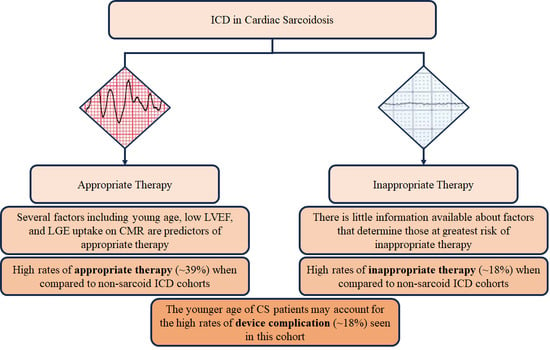Journal Description
Journal of Respiration
Journal of Respiration
is an international, peer-reviewed, open access journal on all aspects of respiratory science in humans published quarterly online by MDPI.
- Open Access— free for readers, with article processing charges (APC) paid by authors or their institutions.
- Rapid Publication: manuscripts are peer-reviewed and a first decision is provided to authors approximately 21.9 days after submission; acceptance to publication is undertaken in 5.5 days (median values for papers published in this journal in the second half of 2023).
- Recognition of Reviewers: APC discount vouchers, optional signed peer review, and reviewer names published annually in the journal.
Latest Articles
ICD in Cardiac Sarcoidosis: Variables Associated with Appropriate Therapy, Inappropriate Therapy, and Device Complications
J. Respir. 2024, 4(2), 102-111; https://doi.org/10.3390/jor4020009 - 13 Apr 2024
Abstract
►
Show Figures
Introduction: Those with cardiac sarcoidosis (CS) are at risk of sudden cardiac death (SCD), which may be prevented using an implantable cardioverter–defibrillator (ICD). There are limited data available that follow the post-procedural outcomes of patients with cardiac sarcoidosis (CS) who have had an
[...] Read more.
Introduction: Those with cardiac sarcoidosis (CS) are at risk of sudden cardiac death (SCD), which may be prevented using an implantable cardioverter–defibrillator (ICD). There are limited data available that follow the post-procedural outcomes of patients with cardiac sarcoidosis (CS) who have had an ICD implanted. Areas Covered: This review highlights studies that focused on both appropriate and inappropriate therapies in those with an ICD, as well as device complications in this group. There were several variables, including age, sex, ventricular characteristics, and findings on cardiac imaging that were investigated and discussed as influencing factors in predicting appropriate and inappropriate therapies. Conclusions: Adverse events in those with an ICD and CS have been minimally reported in the literature. Individuals diagnosed with CS are at high risk of ventricular arrhythmia, with comparable rates of appropriate therapy but with a higher incidence of side effects and inappropriate therapy. The younger average age of CS patients in comparison to other ICD cohorts warrants the need for further, large-scale, prospective trials with periodic interim follow-ups focused on those with this condition.
Full article
Open AccessArticle
Effect of Oscillation and Pulmonary Expansion Therapy on Pulmonary Outcomes after Cardiac Surgery
by
Christopher D. Williams, Kirsten M. Holbrook, Aryan Shiari, Ali A. Zaied, Hussam Z. Al-Sharif, Abdul R. Rishi, Ryan D. Frank, Adel S. Zurob and Muhammad A. Rishi
J. Respir. 2024, 4(2), 91-101; https://doi.org/10.3390/jor4020008 - 02 Apr 2024
Abstract
►▼
Show Figures
Background: Oscillation and pulmonary expansion (OPE) therapy can decrease postoperative pulmonary complications in a general surgical population, but its effect after cardiac surgery has not been reported, to our knowledge. We hypothesized that using an OPE device after cardiac surgery before extubation would
[...] Read more.
Background: Oscillation and pulmonary expansion (OPE) therapy can decrease postoperative pulmonary complications in a general surgical population, but its effect after cardiac surgery has not been reported, to our knowledge. We hypothesized that using an OPE device after cardiac surgery before extubation would decrease pulmonary complications. Methods: This retrospective cohort study included adults undergoing elective open cardiac surgery at our institution from January 2018 through January 2019, who had an American Society of Anesthesiologists score of 3 or greater. For mechanically ventilated patients after cardiac surgery, a new OPE protocol was adopted, comprising an initial 10-min OPE treatment administered in-line with the ventilator circuit, then continued treatments for 48 h after extubation. The primary outcome measure was the occurrence of severe postoperative respiratory complications, including the need for antibiotics, increased use of supplemental oxygen, and prolonged hospital length of stay (LOS). Demographic, clinical, and outcome data were compared between patients receiving usual care (involving post-extubation hyperinflation) and those treated under the new OPE protocol. The primary outcome measure was the occurrence of severe postoperative respiratory complications, including the need for antibiotics, increased use of supplemental oxygen, and prolonged hospital length of stay (LOS). Demographic, clinical, and outcome data were compared between patients receiving usual care (involving post-extubation hyperinflation) and those treated under the new OPE protocol. Results: Of 104 patients, 54 patients received usual care, and 50 received OPE. Usual-care recipients had more men (74% vs. 62%; p = 0.19) and were older (median, 70 vs. 67 years; p = 0.009) than OPE recipients. The OPE group had a significantly shorter hospital LOS than the usual-care group (mean, 6.2 vs. 7.4 days; p = 0.04). Other measures improved with OPE but did not reach significance: shorter ventilator duration (mean, 0.6 vs. 1.1 days with usual care; p = 0.06) and shorter LOS in the intensive care unit (mean, 2.7 vs. 3.4 days; p = 0.06). On multivariate analysis, intensive care unit LOS was significantly shorter for the OPE group (mean difference, −0.85 days; 95% CI, −1.65 to −0.06; p = 0.04). The OPE group had a lower percentage of postoperative complications (10% vs. 20%). Conclusions: OPE therapy after cardiac surgery is associated with decreased intensive care unit (ICU) and hospital LOS.
Full article
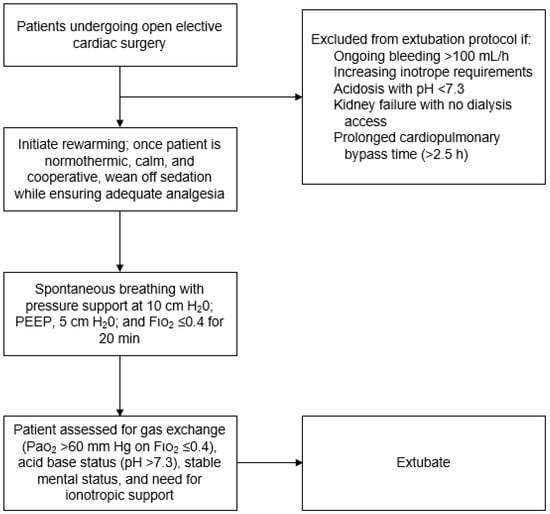
Figure 1
Open AccessReview
Education in Interventional Pulmonology: How We Got Here and Where to Go from Here
by
Dylan Harrell and David M. Chambers
J. Respir. 2024, 4(1), 79-90; https://doi.org/10.3390/jor4010007 - 08 Mar 2024
Abstract
Interventional pulmonology is a rapidly growing field with increasing demand. To meet this demand, training in interventional pulmonology is expanding. What started as a single training program without a standardized curriculum has grown to 40 accredited training programs with a well-defined curriculum that
[...] Read more.
Interventional pulmonology is a rapidly growing field with increasing demand. To meet this demand, training in interventional pulmonology is expanding. What started as a single training program without a standardized curriculum has grown to 40 accredited training programs with a well-defined curriculum that is now overseen by the Accreditation Council for Graduate Medical Education. As the field develops, research is being actively performed to develop validated competency assessment tools and describe the learning curves for pulmonary procedures. As research evolves, this information can be used to better standardize training in interventional pulmonology and move the field towards a competency-based training model.
Full article
(This article belongs to the Special Issue Interventional Pulmonology: An Exciting New Subspecialty within Pulmonary Medicine)
►▼
Show Figures

Figure 1
Open AccessReview
Airway Stents in Interventional Pulmonology
by
Sami I. Bashour and Donald R. Lazarus
J. Respir. 2024, 4(1), 62-78; https://doi.org/10.3390/jor4010006 - 01 Mar 2024
Abstract
Airway stents, first developed in the 1980s, have become fundamental in managing a multitude of airway pathologies and complications within the field of interventional pulmonology. The primary function of an airway stent is to re-establish airway patency and integrity when obstruction, stenosis, anastomotic
[...] Read more.
Airway stents, first developed in the 1980s, have become fundamental in managing a multitude of airway pathologies and complications within the field of interventional pulmonology. The primary function of an airway stent is to re-establish airway patency and integrity when obstruction, stenosis, anastomotic dehiscence, or fistulae develop as a result of various malignant or benign conditions. Nevertheless, airway stents are foreign bodies that can result in complications. In this review article, we will discuss airway stents and their ongoing role in the management of several malignant and benign diseases. We will describe indications for airway stenting and review the elements that must be taken into consideration for optimal patient and stent selection. Given the prevalence of data regarding therapeutic bronchoscopy and airway stenting in malignant airway obstruction, much of the discussion in this review will focus on stent placement for that indication. We will also review the data as it pertains to safety, efficacy, and complications after stent placement, and conclude with a discussion of the future applications and research avenues related to airway stents.
Full article
(This article belongs to the Special Issue Interventional Pulmonology: An Exciting New Subspecialty within Pulmonary Medicine)
►▼
Show Figures
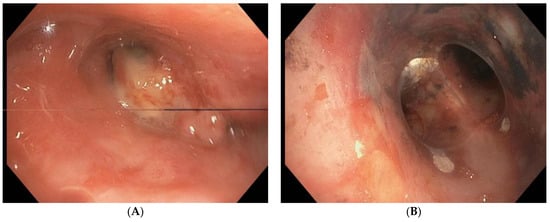
Figure 1
Open AccessReview
Lung Cancer Staging—A Clinical Practice Review
by
Ali B. Rueschhoff, Andrew W. Moore and Maykol R. Postigo Jasahui
J. Respir. 2024, 4(1), 50-61; https://doi.org/10.3390/jor4010005 - 28 Feb 2024
Abstract
Lung cancer is the leading cause of cancer-associated death globally. Staging provides classification of the anatomic extent of cancer that is used consistently worldwide. Lung cancer staging is necessary for prognostication, to inform treatment options, and to allow accurate representation in clinical trials.
[...] Read more.
Lung cancer is the leading cause of cancer-associated death globally. Staging provides classification of the anatomic extent of cancer that is used consistently worldwide. Lung cancer staging is necessary for prognostication, to inform treatment options, and to allow accurate representation in clinical trials. Staging also separates operable from inoperable disease. Since its introduction in the 1970s, the Tumor, Node and Metastasis (TNM) Staging System has undergone significant revisions, with the latest version, the eighth edition, being effective internationally since 2017. Advances in bronchoscopic and thoracoscopic technologies have expanded procedures to diagnose lung cancer and accurately define the anatomic stage. Understanding the advantages and disadvantages of available methods for staging lung cancer is critical to clinician decision making. In patients with lung cancer without distant metastases, the staging of mediastinal lymph nodes determines treatment options. To minimize the risk and cost, the most appropriate method of staging should identify the highest disease stage while carrying acceptable risk. Minimally invasive endoscopic needle techniques to stage the mediastinum are the first choice to assess for metastases in accessible lymph node stations. Surgical techniques are generally reserved for specific clinical situations, including following negative endoscopic needle techniques when suspicion for nodal involvement is high and to assess endoscopically inaccessible lymph nodes. This review provides a concise account of TNM staging of non-small cell lung cancer (NSCLC) and overview of procedures available for the staging of lung cancer.
Full article
(This article belongs to the Special Issue Interventional Pulmonology: An Exciting New Subspecialty within Pulmonary Medicine)
►▼
Show Figures
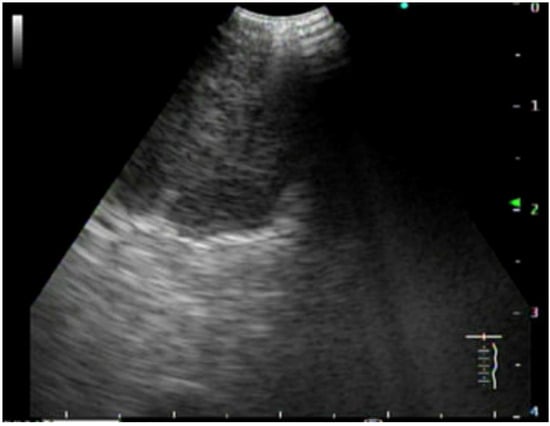
Figure 1
Open AccessReview
A Review of Medical Thoracoscopy and Its Role in Management of Malignant Pleural Effusion
by
Michael Gioia and Rosa L. Arancibia
J. Respir. 2024, 4(1), 35-49; https://doi.org/10.3390/jor4010004 - 26 Feb 2024
Abstract
Pleural effusion is the most common disease among all pleural diseases and affects 1.5 million patients per year in the United States. Different interventions can be performed when dealing with pleural effusions. In this review, we present medical thoracoscopy as a minimally invasive
[...] Read more.
Pleural effusion is the most common disease among all pleural diseases and affects 1.5 million patients per year in the United States. Different interventions can be performed when dealing with pleural effusions. In this review, we present medical thoracoscopy as a minimally invasive procedure with both diagnostic and therapeutic utility in the management of pleural disease. It has a higher diagnostic yield than commonly performed percutaneous procedures (thoracentesis, closed pleural biopsy) and simultaneously offers many of the therapeutic benefits of more invasive procedures, such as video-assisted thoracoscopic surgery, with a lower risk profile. The role of medical thoracoscopy is evolving and will likely continue to expand as more centers start performing the procedure nationwide.
Full article
(This article belongs to the Special Issue Interventional Pulmonology: An Exciting New Subspecialty within Pulmonary Medicine)
►▼
Show Figures

Figure 1
Open AccessReview
Bronchoscopy and Thermal Ablation: A Review Article
by
Aristides J. Armas Villalba and Bruce F. Sabath
J. Respir. 2024, 4(1), 26-34; https://doi.org/10.3390/jor4010003 - 29 Jan 2024
Abstract
Thermal ablative techniques are part of the armamentarium of interventional pulmonologists for the treatment of a diverse range of pathologies, but most importantly used in airway obstruction and airway bleeding. These techniques can be categorized based on their onset of action into rapid
[...] Read more.
Thermal ablative techniques are part of the armamentarium of interventional pulmonologists for the treatment of a diverse range of pathologies, but most importantly used in airway obstruction and airway bleeding. These techniques can be categorized based on their onset of action into rapid and delayed ablative methods. Understanding the nuances of each technique is essential, as most clinical scenarios demand a combination of modalities, commonly referred to as a “multi-modality approach”. This comprehensive review aims to elucidate the fundamental principles of rapid ablative techniques, including laser therapy, argon plasma coagulation (APC), and electrocautery, along with the research that underpins their clinical application.
Full article
(This article belongs to the Special Issue Interventional Pulmonology: An Exciting New Subspecialty within Pulmonary Medicine)
Open AccessArticle
Clinical and Functional Characteristics of Interstitial Lung Disease in Algeria: A Single-Center Prospective Study
by
Abdelbassat Ketfi, Fayçal Selatni, Cherifa Djouadi and Rama Touahri
J. Respir. 2024, 4(1), 12-25; https://doi.org/10.3390/jor4010002 - 29 Dec 2023
Abstract
Introduction: There are a limited number of epidemiological studies describing the global burden of chronic diffuse interstitial lung diseases (ILD) and their subtypes’ heterogeneity worldwide. Our main is to characterize new-onset ILDs in Algeria and compare our results with data from other populations.
[...] Read more.
Introduction: There are a limited number of epidemiological studies describing the global burden of chronic diffuse interstitial lung diseases (ILD) and their subtypes’ heterogeneity worldwide. Our main is to characterize new-onset ILDs in Algeria and compare our results with data from other populations. Materials and Methods: Newly diagnosed ILDs were prospectively collected in a single-center observational cohort study including all patients diagnosed as ILDs in the pulmonology, phthisiology, and allergology departments between 2015 and 2019. Detailed anamnestic and clinical data were collected at the time of diagnosis. The results of high-resolution computed tomography (HRCT), serological tests, biology data, and respiratory functional exploration were systematically performed and collected. Results: A total of 455 cases were included. The mean age was 59.4 ± 13.2 years. There was a slight predominance of females (300; 65.9%). The most common disease was ILD secondary to connective tissue disease (CTD) or ILD-CTD (48.1%), followed by idiopathic interstitial pneumonias (IIPs) (23.5%), sarcoidosis (16.9%), interstitial pneumonia with autoimmune features (IPAF) (12.1%), and hypersensitivity pneumonitis (HP) (2.4%). Idiopathic pulmonary fibrosis (IPF) was present in 8.6% and unclassifiable ILD in 4.6% of the total ILD cases. Conclusions: ILD-CTD, IIP, and sarcoidosis were the most frequently observed ILDs in this Algerian population. Similarities and many differences were found compared to previous data from other countries.
Full article
(This article belongs to the Special Issue Pulmonary Fibrosis: Pathophysiology and Novel Therapeutic Approaches)
Open AccessArticle
Thromboelastography-Guided Anticoagulation in Critically Ill COVID-19 Patients: Mortality and Bleeding Outcomes
by
Sean Duenas, Juliana Derfel, Margaret Gorlin, Serena Romano, Wei Huang, Alex Smith, Javier Ticona, Cristina Sison, Martin Lesser, Linda Shore-Lesserson, Negin Hajizadeh and Janice Wang
J. Respir. 2024, 4(1), 1-11; https://doi.org/10.3390/jor4010001 - 23 Dec 2023
Abstract
►▼
Show Figures
Hypercoagulability in COVID-19 patients was associated with increased mortality risk during the pandemic. This retrospective, observational study investigated whether the use of a thromboelastography (TEG)-guided anticoagulation protocol could decrease death and bleeding in critically ill COVID-19 patients. A TEG-guided protocol was instituted in
[...] Read more.
Hypercoagulability in COVID-19 patients was associated with increased mortality risk during the pandemic. This retrospective, observational study investigated whether the use of a thromboelastography (TEG)-guided anticoagulation protocol could decrease death and bleeding in critically ill COVID-19 patients. A TEG-guided protocol was instituted in one of two intensive care units. Primary outcomes of composite scores were the following: (0) major bleed and death; (1) death without major bleed; (2) major bleed without death; and (3) no bleed or death. Out of 134 patients, 67 in the TEG group were propensity matched to 67 in the comparator group based on age, gender, body mass index, presence of chronic kidney disease, cardiovascular disease, diabetes, and duration of non-invasive ventilation. There were no significant differences in rates of composite outcomes of bleeding or death in patients managed with or without a TEG-guided protocol (p = 0.22, Bowker symmetry testing). Out of the 67 patients in the TEG group, the TEG protocol led to anticoagulation change in 26 patients. Death was lower in this TEG-changed group (54%) compared to the comparator group (81%), although not significant (p = 0.07). TEG-guided protocol use did not reduce composite outcomes of death and bleeding, Future studies may further elucidate potential benefits.
Full article

Figure 1
Open AccessArticle
Breathe out the Secret of the Lung: Video Classification of Exhaled Flows from Normal and Asthmatic Lung Models Using CNN-Long Short-Term Memory Networks
by
Mohamed Talaat, Xiuhua Si and Jinxiang Xi
J. Respir. 2023, 3(4), 237-257; https://doi.org/10.3390/jor3040022 - 14 Dec 2023
Abstract
►▼
Show Figures
In this study, we present a novel approach to differentiate normal and diseased lungs based on exhaled flows from 3D-printed lung models simulating normal and asthmatic conditions. By leveraging the sequential learning capacity of the Long Short-Term Memory (LSTM) network and the automatic
[...] Read more.
In this study, we present a novel approach to differentiate normal and diseased lungs based on exhaled flows from 3D-printed lung models simulating normal and asthmatic conditions. By leveraging the sequential learning capacity of the Long Short-Term Memory (LSTM) network and the automatic feature extraction of convolutional neural networks (CNN), we evaluated the feasibility of the automatic detection and staging of asthmatic airway constrictions. Two asthmatic lung models (D1, D2) with increasing levels of severity were generated by decreasing the bronchiolar calibers in the right upper lobe of a normal lung (D0). Expiratory flows were recorded in the mid-sagittal plane using a high-speed camera at 1500 fps. In addition to the baseline flow rate (20 L/min) with which the networks were trained and verified, two additional flow rates (15 L/min and 10 L/min) were considered to evaluate the network’s robustness to flow deviations. Distinct flow patterns and vortex dynamics were observed among the three disease states (D0, D1, D2) and across the three flow rates. The AlexNet-LSTM network proved to be robust, maintaining perfect performance in the three-class classification when the flow deviated from the recommendation by 25%, and still performed reasonably (72.8% accuracy) despite a 50% flow deviation. The GoogleNet-LSTM network also showed satisfactory performance (91.5% accuracy) at a 25% flow deviation but exhibited low performance (57.7% accuracy) when the deviation was 50%. Considering the sequential learning effects in this classification task, video classifications only slightly outperformed those using still images (i.e., 3–6%). The occlusion sensitivity analyses showed distinct heat maps specific to the disease state.
Full article
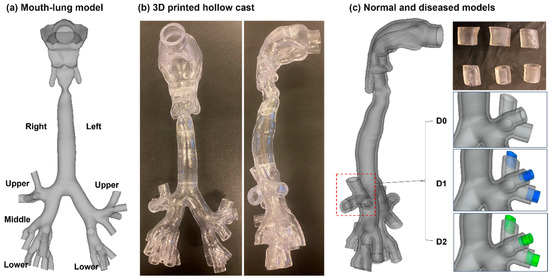
Figure 1
Open AccessReview
Primary Resistance to EGFR Tyrosine Kinase Inhibitors (TKIs): Contexts and Comparisons in EGFR-Mutated Lung Cancer
by
Keigo Kobayashi
J. Respir. 2023, 3(4), 223-236; https://doi.org/10.3390/jor3040021 - 13 Dec 2023
Abstract
►▼
Show Figures
The discovery of the efficacy of tyrosine kinase inhibitors (TKIs) in epidermal growth factor receptor (EGFR)-mutated non-small-cell lung cancer (NSCLC) patients has revolutionized lung cancer therapy. Although almost all responders acquire drug resistance within a few years, many studies have revealed
[...] Read more.
The discovery of the efficacy of tyrosine kinase inhibitors (TKIs) in epidermal growth factor receptor (EGFR)-mutated non-small-cell lung cancer (NSCLC) patients has revolutionized lung cancer therapy. Although almost all responders acquire drug resistance within a few years, many studies have revealed several acquired-resistant mechanisms and developed therapeutic strategies countervailing them, most notably against the EGFR T790M gatekeeper mutation. However, little progress has been made in terms of elucidating the mechanisms of primary resistance. Primary resistance may be defined into two types of resistance, clinically representing patients that do not respond (non-responders) to EGFR-TKIs. The first group consists of approximately 10% of patients that are insensitive to EGFR-TKIs from the outset (intrinsic primary resistance), and 20–30% of the second group consists of patients that seem to clinically benefit at first, but experience early relapse within six months (late primary resistance). In this review, we first provide an overview of drug-induced lung cancer dynamics. We then delve into the mechanisms of primary resistance, with a primary focus on two specific subtypes of resistance. We suggest that “intrinsic primary resistance” is characterized by pre-existing somatic and genomic changes and cell of origins, while “late primary resistance” is correlated with the drug-tolerant persister state. Developing therapeutic strategies to overcome primary resistance is crucial to prolonging the duration of EGFR-TKI therapy. Ultimately, this will allow for an enhanced understanding of lung cancer’s evolutional process, leading to the reversal of acquired resistance and the complete eradication of lung cancer.
Full article
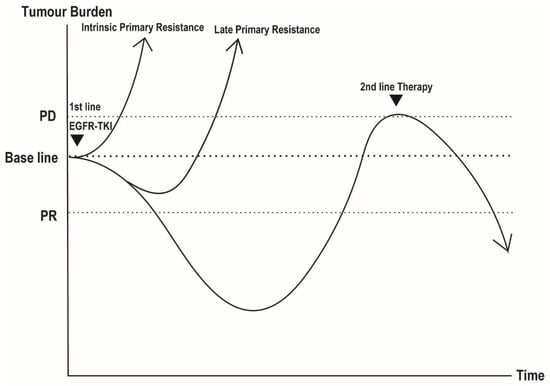
Figure 1
Open AccessReview
Thoracentesis for the Diagnosis and Management of Pleural Effusions: The Current State of a Centuries-Old Procedure
by
Michael J. Nicholson, Christopher Manley and Danish Ahmad
J. Respir. 2023, 3(4), 208-222; https://doi.org/10.3390/jor3040020 - 08 Dec 2023
Cited by 1
Abstract
Thoracentesis is a fundamental procedure in interventional pulmonology, providing both diagnostic and therapeutic value. This review article offers a comprehensive analysis of thoracentesis, delving into pleural anatomy, procedural techniques, indications, and recent advancements. The article details the evolution of thoracentesis, including the crucial
[...] Read more.
Thoracentesis is a fundamental procedure in interventional pulmonology, providing both diagnostic and therapeutic value. This review article offers a comprehensive analysis of thoracentesis, delving into pleural anatomy, procedural techniques, indications, and recent advancements. The article details the evolution of thoracentesis, including the crucial role of ultrasound guidance and emerging approaches that enhance precision and minimize complications. It addresses the wide range of indications for thoracentesis in diverse clinical scenarios, from the diagnosis of pleural effusions to therapeutic drainage of pleural collections. Furthermore, this review explores the management of coagulopathy and anticoagulation pertaining to thoracentesis. It will also provide strategies for preventing and managing complications, ensuring that thoracentesis remains a well-tolerated procedure with minimal risks. This article concludes by examining future directions in thoracentesis, including potential innovations and trends that will shape the landscape of interventional pulmonary medicine. This review serves as an essential resource for pulmonologists, interventional radiologists, and healthcare professionals, offering a comprehensive update on thoracentesis.
Full article
(This article belongs to the Special Issue Interventional Pulmonology: An Exciting New Subspecialty within Pulmonary Medicine)
►▼
Show Figures

Figure 1
Open AccessReview
The Role of Nintedanib in the Treatment of Progressive Pulmonary Fibrosis of Autoimmune-Related Interstitial Lung Disease
by
Aulia Rahman Ardan and Fariz Nurwidya
J. Respir. 2023, 3(4), 200-207; https://doi.org/10.3390/jor3040019 - 22 Nov 2023
Abstract
►▼
Show Figures
Interstitial lung disease (ILD), which is characterized by pulmonary fibrosis, is a diverse group of disorders. Nintedanib, an antifibrotic drug, is known to attenuate disease progression in ILD with progressive fibrosis, but its efficacy in autoimmune-disease-related ILD remains uncertain. We conducted a comprehensive
[...] Read more.
Interstitial lung disease (ILD), which is characterized by pulmonary fibrosis, is a diverse group of disorders. Nintedanib, an antifibrotic drug, is known to attenuate disease progression in ILD with progressive fibrosis, but its efficacy in autoimmune-disease-related ILD remains uncertain. We conducted a comprehensive search for relevant randomized controlled trials, systematic reviews and meta-analyses included in PubMed, ScienceDirect and Scopus databases as of 23 June 2022 and manually reviewed reference lists. Among the 689 titles and abstracts screened, 24 studies were considered, with 4 randomized controlled trials included in our review. Nintedanib, administered at 150 mg twice daily for 52 weeks, consistently slowed forced vital capacity decline. Enhanced efficacy was observed when combining nintedanib with immunomodulators, and the most common adverse effect was diarrhea. In conclusion, our study suggests that nintedanib is a safe option for mitigating the progression of autoimmune-disease-related ILD, providing valuable insights into its potential therapeutic role in this context.
Full article
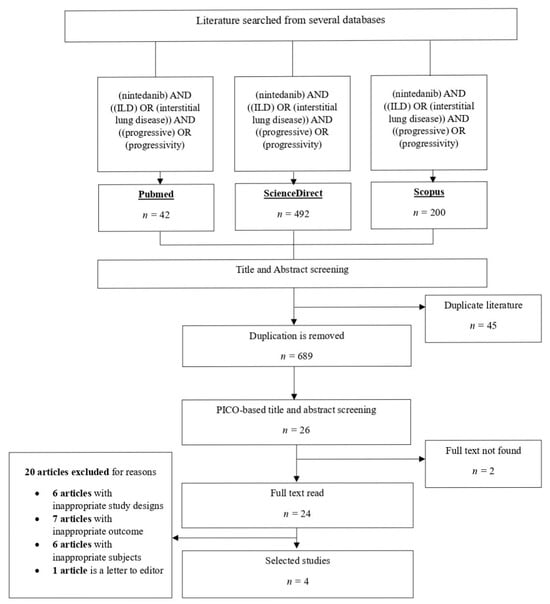
Figure 1
Open AccessArticle
Compassion Satisfaction, Burnout, and Secondary Traumatic Stress among Respiratory Therapists in Mississippi: A Cross-Sectional Study
by
Driscoll DeVaul, Britney Reulet, Jacob Daniels, Xiaoqian Zhu, Renee Wilkins and Xiaoshan Z. Gordy
J. Respir. 2023, 3(4), 191-199; https://doi.org/10.3390/jor3040018 - 08 Nov 2023
Abstract
The COVID-19 pandemic had an immense effect on the well-being of healthcare professionals. In this study, researchers utilized a quantitative cross-sectional study design to investigate the degree of compassion satisfaction and fatigue amongst respiratory therapists in the state of Mississippi as a result
[...] Read more.
The COVID-19 pandemic had an immense effect on the well-being of healthcare professionals. In this study, researchers utilized a quantitative cross-sectional study design to investigate the degree of compassion satisfaction and fatigue amongst respiratory therapists in the state of Mississippi as a result of providing care to patients during the COVID-19 pandemic. Quantitative data were collected using an anonymous online survey that assessed the well-being and satisfaction of licensed respiratory therapists in the state of Mississippi. More specially, survey responses (n = 326) were quantitatively evaluated to measure the association between demographic variables and compassion satisfaction (CS), burnout (BO), and secondary traumatic stress (STS). Ninety-seven percent of participants reported a medium to high CS level, while 74% indicated having a medium to high level of BO, and 69% reported a medium to high level of STS. Neither age nor gender had a significant difference in CS (p = 0.504; p = 0.405), BO (p = 0.161; p = 0.285), or STS (p = 0.145; p = 0.252). Those working for more than 10 years at their current employer had higher CS (M = 38.7) and lower BO (M = 24.9) and STS (M = 24.8) scores. The number of hours worked, specifically overtime, had a significant impact on BO (β = 0.09, p = 0.028) and STS (β = 0.0.11, p = 0.019), but not CS (β = 0.02, p = 0.655). These findings suggest that the number of years employed in the field impacts the level of compassion satisfaction and contributes to lower levels of burnout and secondary traumatic stress. The age of a patient may also affect levels of compassion and burnout. The results of this study highlight the importance of developing incentive plans in an effort to retain employees.
Full article
Open AccessArticle
Is Bronchiectasis (BE) Properly Investigated in Patients with Severe Asthma? A Real-Life Report from Eight Italian Centers
by
Giovanna Elisiana Carpagnano, Vitaliano Nicola Quaranta, Claudia Crimi, Pierachille Santus, Francesco Menzella, Corrado Pelaia, Giulia Scioscia, Cristiano Caruso, Elena Bargagli, Nicola Scichilone and Eva Polverino
J. Respir. 2023, 3(4), 178-190; https://doi.org/10.3390/jor3040017 - 02 Oct 2023
Abstract
►▼
Show Figures
Introduction: Asthma and bronchiectasis are often partners in a complex but uneven relationship with asthma receiving more attention. The aim of this study is to describe how bronchiectasis is investigated in some Severe Asthma (SA) Centers, scattered throughout the Italian territory. Materials and
[...] Read more.
Introduction: Asthma and bronchiectasis are often partners in a complex but uneven relationship with asthma receiving more attention. The aim of this study is to describe how bronchiectasis is investigated in some Severe Asthma (SA) Centers, scattered throughout the Italian territory. Materials and Methods: We enrolled 92 patients with SA and bronchiectasis from eight Italian SA Centers and recorded diagnostic approaches to investigate SA and bronchiectasis at the time of enrollment (T0), at the 6-month (T1), and at the 12-month (T2) follow-up visits. Results: A statistically significant heterogeneous diagnostic approach emerged across the centers under study. In fact, while, as expected, all involved centers made an in-depth investigation of SA, only a few of them provided a complete investigation of bronchiectasis in order to provide specific treatment. Discussion: This real-life multicenter study confirmed that patients with coexistent SA and bronchiectasis are mainly investigated for pheno-endotyping asthma but rarely for the complete assessment of bronchiectasis. We believe that the diagnostic flowchart of SA patients with suspicion or confirmed bronchiectasis needs to be clarified and implemented as the association of these conditions strongly influences the final outcome and management of these patients.
Full article
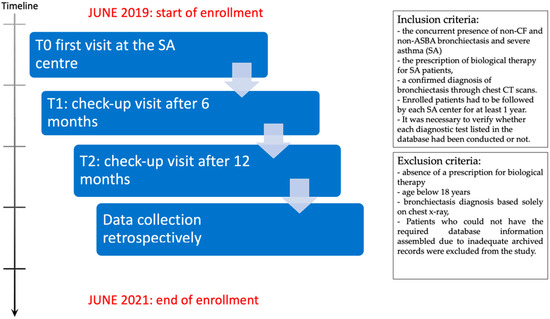
Figure 1
Open AccessReview
Induction and Modulation of EVs by Cigarette Smoke and Their Relevance in Lung Disease: Recent Advances
by
Mengli Zhong, Muhan Zou, Yue Yao, Hao Wu, Weiwei Su, Yonggang Wang and Peibo Li
J. Respir. 2023, 3(4), 164-177; https://doi.org/10.3390/jor3040016 - 26 Sep 2023
Abstract
►▼
Show Figures
Cigarette combustion has the potential to generate over 7000 chemicals, the majority of which are reactive free radicals that are known to trigger pro-inflammatory and carcinogenic responses. Numerous contemporary investigations have proposed that the pathophysiological and cellular mechanisms underlying the release of extracellular
[...] Read more.
Cigarette combustion has the potential to generate over 7000 chemicals, the majority of which are reactive free radicals that are known to trigger pro-inflammatory and carcinogenic responses. Numerous contemporary investigations have proposed that the pathophysiological and cellular mechanisms underlying the release of extracellular vesicles (EVs) in response to cigarette smoke (CS) may serve as potential pathways for CS-induced pathogenesis, while also reflecting the physiological state of the originating cells. This review provides a concise overview of the pathophysiological mechanisms linked to CS-induced EVs in various lung diseases, including chronic obstructive pulmonary disease, lung cancer, pulmonary fibrosis, and pulmonary hypertension. Additionally, it explores the potential and prospects of EVs as diagnostic biomarkers for CS-related lung diseases.
Full article

Figure 1
Open AccessReview
Mapping the Global Adoption of Mandatory Vaccination against COVID-19: A Scoping Review
by
Jessica U. Damian and Takalani G. Tshitangano
J. Respir. 2023, 3(3), 153-163; https://doi.org/10.3390/jor3030015 - 18 Aug 2023
Abstract
►▼
Show Figures
The coronavirus (COVID-19) pandemic caused sicknesses ranging from mild to deadly, which disrupted lives and healthcare systems across the globe. Despite the availability of vaccines that are effective in significantly reducing the risks of death and severe disease, misperceptions of COVID-19 vaccine safety,
[...] Read more.
The coronavirus (COVID-19) pandemic caused sicknesses ranging from mild to deadly, which disrupted lives and healthcare systems across the globe. Despite the availability of vaccines that are effective in significantly reducing the risks of death and severe disease, misperceptions of COVID-19 vaccine safety, efficacy, risks, and mistrust in institutions responsible for vaccination campaigns have been reported as factors contributing to vaccine hesitancy, leading to an unsatisfactory vaccination rate, which resulted in some countries implementing mandatory COVID-19 vaccination to increase vaccine uptake. This scoping review aimed at mapping global countries that have adopted mandatory COVID-19 vaccination and the reaction of citizens. PRISMA Extension for Scoping Reviews was used. Google Scholar was used to identify papers published in English from December 2019 to February 2022, irrespective of their methodology. A total of 140 studies were identified. After screening for duplication, access, and relevance, 24 were eligible for review. Approximately eleven countries implemented mandatory vaccination, mostly among healthcare workers. Citizens’ reactions towards the policy varied, with some in support of the policy but with a preference for the healthcare workers, and some in support but with the condition that it will only apply to travel, schools, and shopping areas, while others rejected the policy. Studies that may be relevant but were excluded due to eligibility criteria may be a limiting factor to this study. Several ethical considerations should be explicitly addressed when evaluating whether mandatory COVID-19 vaccination is an ethically justifiable policy option as recommended by the WHO policy brief.
Full article

Figure 1
Open AccessArticle
Assessment of Students’ Knowledge Regarding PTB and Its Causes at Rural Institution of Higher Learning in South Africa
by
Joseph Neluheni, Joseph M. Mundadi, Takalani R. Luhalima and Thivhulawi Malwela
J. Respir. 2023, 3(3), 141-152; https://doi.org/10.3390/jor3030014 - 20 Jul 2023
Abstract
Background: TB is a significant public health problem around the world, with South Africa being one of the 30 high-burden TB countries, accounting for 87 percent of all estimated incident TB cases. In South Africa, which accounts for 3% of all instances worldwide,
[...] Read more.
Background: TB is a significant public health problem around the world, with South Africa being one of the 30 high-burden TB countries, accounting for 87 percent of all estimated incident TB cases. In South Africa, which accounts for 3% of all instances worldwide, research on students’ experiences and understanding of underlying factors is lacking. These future leaders are still in a key time of physical and psychological development. This study aimed to test students’ understanding of pulmonary tuberculosis (PTB) and its causes at a rural institution of higher learning. Methodology: Quantitative method was used using a cross-sectional design. The study was conducted in the 2020 Vhembe District, Limpopo, South Africa. In the poll, 199 students living in overcrowded campus housing were interviewed. A self-administered questionnaire was used to collect data at the Thohoyandou campus. Data were analysed using version 26.0 of the Statistical Package for Social Sciences (SPSS), with a Spearman’s rank-order correlation run. Results: The findings of this study revealed that 25.6 percent of male students and 74.4 percent of female students, respectively, understood PTB, while students at the selected tertiary institution have insufficient awareness of the causes of PTB. The association between education and TB knowledge among the respondents was determined using Spearman’s rank-order correlation. There was a statistically significant positive association between education and TB knowledge (Spearman’s rho = 0.669, p = 0.035). Conclusions: The study found that students at a higher education institution lacked sufficient general Knowledge regarding PTB. PTB control measures should be adopted to implement better the NSP, NDP, Global STOP TB strategy and the SDGs.
Full article
Open AccessArticle
Adherence to Pulmonary Rehabilitation in Patients with Chronic Obstructive Pulmonary Disease (COPD)
by
Jhonatan Betancourt-Peña, Juan Carlos Ávila-Valencia and Jenifer Rodríguez-Castro
J. Respir. 2023, 3(3), 130-140; https://doi.org/10.3390/jor3030013 - 18 Jul 2023
Cited by 1
Abstract
►▼
Show Figures
Background: Pulmonary rehabilitation (PR) allows for the treatment of patients with chronic obstructive pulmonary disease (COPD) as an intervention strategy that improves functional capacity, dyspnea, and health-related quality of life. However, adherence to such programs might be improved. This study aimed to describe
[...] Read more.
Background: Pulmonary rehabilitation (PR) allows for the treatment of patients with chronic obstructive pulmonary disease (COPD) as an intervention strategy that improves functional capacity, dyspnea, and health-related quality of life. However, adherence to such programs might be improved. This study aimed to describe the differences in sociodemographic and clinical variables, functional capacity, and health-related quality of life in patients diagnosed with COPD adherent and non-adherent to pulmonary rehabilitation at a clinic in Cali, Colombia. Methods: This study followed a descriptive cross-sectional model with 150 patients diagnosed with COPD. Adherence was classified by taking into account the number of sessions completed: low (<35%), moderate (35–85%), and high (>85%). Sociodemographic, clinical, functional capacity, and health-related quality of life variables were considered. Results: Adherence to the PR was rated as high in 57.3% of patients. Variables such as sex, health system affiliation, height, functional capacity, resting SaO2, and health-related quality of life presented significant differences (p-value ≤ 0.05). The main causes of non-adherence to the program were medical recommendations that prevented continuing in the program due to clinical and safety issues and economic issues that prevented reaching the rehabilitation site, as it was unaffordable. Conclusions: It can be concluded that adherence to pulmonary rehabilitation was rated as high in 57.3% of patients. The high adherence to the PR program occurred in male patients with a capacity to pay the Colombian health system (contributory regime).
Full article
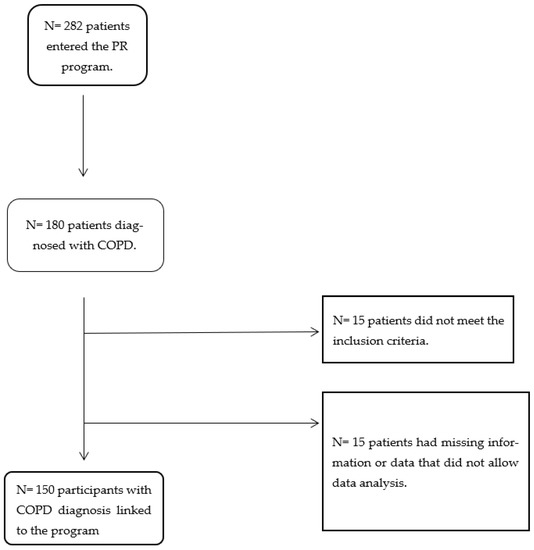
Figure 1
Open AccessArticle
Smoking Cessation Rates among Pregnant Women and Their Relapse Rates in the Postpartum Period in Samsun
by
Bektas Murat Yalcin, Tugba Kertmen and Muge Ustaoglu
J. Respir. 2023, 3(3), 118-129; https://doi.org/10.3390/jor3030012 - 05 Jul 2023
Abstract
►▼
Show Figures
Objective: This research aimed to determine the smoking frequency and smoking-related gestational and postpartum health problems in our study population. We investigated the quit rate during pregnancy and relapse after giving birth. The study was conducted in two university family health centers. A
[...] Read more.
Objective: This research aimed to determine the smoking frequency and smoking-related gestational and postpartum health problems in our study population. We investigated the quit rate during pregnancy and relapse after giving birth. The study was conducted in two university family health centers. A total of 270 women aged 18–45 with children were included in the study. Following receipt of verbal consent, the cases’ demographic data, previous obstetric information, smoking status, and gestational weight gain (GWG) were collected through face-to-face interviews and electronic records. The participants’ mean age was 35.75 ± 6.9 years and 28.1% were current smokers. Forty-one participants (16%) smoked during pregnancy, while the secondhand smoking rate was 30%. Ex-smokers experienced greater GWG (17.5 ± 1.7 kg (p = 0.003)) than current smokers and non-smokers. Small gestational age (SGA) and health problems in the first year of life were more frequent in the babies of smoker mothers (p < 0.05). The relapse rate was 81.4%, and the mean relapse interval was 13.9 ± 1.85 months. Having a smoker spouse (0.42 Exp(B), p = 0.035) and high GWG (0.98 Exp(B), p = 0.01) were identified as independent risk factors for relapse. Our results indicate that many of the smoker women quit during pregnancy. Special interventions may increase the quitting rate in pregnancy and reduce the subsequent relapse rate.
Full article

Figure 1
Highly Accessed Articles
Latest Books
E-Mail Alert
News
Topics

Conferences
Special Issues
Special Issue in
JoR
Pulmonary Fibrosis: Pathophysiology and Novel Therapeutic Approaches
Guest Editor: Arun SamiduraiDeadline: 30 June 2024
Special Issue in
JoR
Mediastinal Lesions: Novel Diagnostics and Therapeutic Approaches
Guest Editor: Cesar A. MoranDeadline: 1 September 2024
Special Issue in
JoR
Histiocytic Disorders of the Lung: Updates in Diagnosis, Molecular Alterations, and Novel Therapeutics Options
Guest Editor: Sergio Piña-OviedoDeadline: 30 September 2024
Topical Collections
Topical Collection in
JoR
Feature Papers in Journal of Respiration
Collection Editor: Cesar A. Moran
